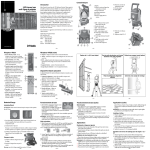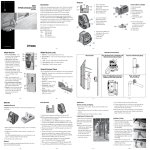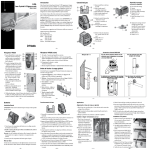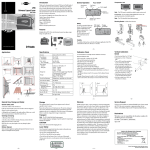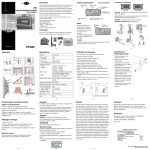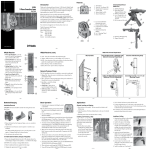Download Spectra 1.5PL User's Manual
Transcript
Features Introduction • 1.5PL Precision Multi-Line Laser User Guide 1 2 Thank you for choosing the Spectra Precision® 1.5PL from the Trimble® family of precision products. This simple-to-use tool allows you to perform leveling or vertical plumb work. You can also use the laser outdoors for leveling and aligning applications (optional HR220 receiver required). Before using the laser, be sure to read this operator’s manual carefully. Included in it is information about setting up, using, and maintaining the laser. Also included in this manual are CAUTIONS and Notes. Each of these words represents a level or danger or concern. A CAUTION indicates a hazard or unsafe practice that could result in minor injury or property damage. A Note indicates important information unrelated to safety. 14. Battery Door Knob 15. Recharge Jack 16. Adjustable Legs 3 Your comments and suggestions are welcome; please contact us at: Trimble Spectra Precision Division 8261 State Route 235 Dayton, Ohio 45424 U.S.A. Phone: (937) 245-5600 (800) 538-7800 FAX: (937) 482-0030 Internet:www.trimble.com/spectra 1.Handle 2. Laser Line Exit Windows Horizontal and Vertical 3. Unit ON/OFF Compensator Lock / Manual Mode Knob 4. Fine Alignment Knobs 14 5. Power On / Low Battery LED 6. Manual Mode Button 7. Manual Mode On LED 8. Receiver Mode Button 9. Receiver Mode On LED 10. Vertical (front) Beam Button 11. Horizontal Beam Button 12. Vertical (left/right) Beams Button 13. Vial (Red/Green) 4 13 9 6 8 15 16 17. Plumb-Down Beam Exit Window 18. 5/8 x 11 Mounting Thread 12 10 www.trimble.com 5 11 –3– –2– HR220 Receiver 17 7 18 –4– HR220 Receiver (cont.) 1. Power and Audio Button – turns the receiver ON and OFF and changes the audio to LOUD, LOW or OFF. a. Automatic Shutoff - If the photocell does not detect the laser beam for 30 minutes, the receiver shuts off automatically. 2. Marking Notches (both sides) – align with the on-grade portion of the photocell and are used to mark elevation readings. The marking notches are 50 mm (2 in.) from the top of the receiver. 3. Liquid Crystal Display (LCD) – displays the elevation, power, audio and battery status. 4. Bubble vials - aids in keeping receiver level in both horizontal and vertical planes. 5. Photocell – detects the laser beam when it strikes the receiver. 6. Audio Port – is the opening the sound comes out of. 7. Clamp-Tab Recess – is the area that the general-purpose clamp’s release tab fits into. 4 5 3 2 1 6 8. Label – shows the serial number and manufacturing date. 9. Magnet—holds the receiver on a wall molding, cross-T, runner, etc. 10.LEDs – show the position of the receiver relative to the laser beam (above grade [red], on grade [green] or below grade [blue]). 11.Battery Housing – holds 2 AA alkaline batteries. 12.Battery Door Latch– opens the battery compartment. 1 M (4 Ft) Marks Using a Tripod Over Tall Floor Track or Obstacles Using the Extendable Legs Ceiling with (optional) Wall Mount Tile Laying with Angle Alignment Columns with Mounting Strap General-Purpose Clamp 9 8 7 10 11 The C61 clamp allows the receiver to be attached to a survey rod or wooden pole. 1. Release Tab – allows the receiver to be locked onto or released from the general-purpose clamp. 2. Jaws – close/open so that the general-purpose clamp can be attached to or released from a survey rod or wooden pole. 3. Jaws Screw – controls the closing/ 1 opening of the jaws. 2 4. Reading Edge – aligns with the receiver’s on-grade marking notches. 3 5. Bubble Screw Holes – are where the optional 1277-6251S rod bubble kit is mounted. 12 5 4 –6– –5– –7– –8– Batteries/Charging Basic Operation Basic Operation (cont.) Applications (cont.) Installation/Removal 1. Unlock the laser’s compensator by turning the compensator lock/ unlock knob to the LEFT. The Power On/Low Battery LED illuminates RED and the vial lights GREEN when the unit has been set up inside its self-leveling range. When the batteries need to be charged/changed the Power On / Low Battery LED flashes RED. Note: For added mechanism protection always lock the laser when not in use by turning the compensator lock/ unlock knob to the RIGHT. Note: The receiver mode can be used in automatic self-leveling and in manual mode. 2. To turn OFF the receiver mode, PRESS the RECEIVER button again. To turn OFF the unit and the beams, PRESS the buttons V1, H and V2 again and turn the compensator lock/ unlock knob to the RIGHT. 4. To locate the plumb point over a wall corner or other point place the Down Point Beam over the corner or mark. Use the intersecting cross lines to determine the top track corner location. Note: If the floor track is already installed use the extendable legs to position the Down Point over the corner. CAUTION: The batteries should be removed when storing the laser more than 30 days. 1. Turn the battery door knob counterclockwise to release the battery pack. 2. Install/remove the 4 x AA batteries. Note: When installing the batteries, be sure to note the positive (+) and negative (–) diagrams molded on the battery housing. 3. Put the battery pack in place and lock it by turning the knob clockwise. Battery Charger 1. Plug the battery recharger’s plug into the laser’s battery recharging jack. 2. Plug the battery recharger into the wall outlet. Note: A full charge will be reached in 4-5 hours. –9– Automatic Mode 1. Turn the compensator knob to the On-Position- the Power On / Low Battery LED illuminates RED and the vial lights GREEN when the unit has been set up inside its self-leveling range. 2. The beams can be activated/deactivated using the buttons V1 V line H H line V2 V lines Left/Right 3. When the unit is tilted out of its self-leveling range the vial lights RED, all beams flash and the unit beeps a warning tone. Manual Mode 1. The laser can be taken out of automatic self-leveling mode to perform slope work by turning the compensator lock/ unlock knob to the RIGHT. 2. Press the MANUAL button. The Power On / Low Battery LED illuminates RED. The Manual LED flashes RED and the vial lights RED. Receiver Mode 1. To operate the laser with the HR220 receiver press the RECEIVER button. The RECEIVER LED will illuminate RED. – 10 – Applications General Leveling and Aligning 1. Place the laser on a flat surface. The laser must be level within its selfleveling range. 2. Adjust the position of the lines and plumb point so they are at the desired positions. 3. Mark the position of the wall, elevation, floor or ceiling. Installing and Plumbing a Wall 1. Place the laser so the Vertical Line Beam is positioned over the desired wall location (usually indicated by 2 floor marks). Note: If the floor track is already installed the laser should be setup using the extendable legs so the Vertical Line can be positioned over the edge of the track. 2. Use the Vertical Line Beam to position the top track. 3. Use the Vertical Line Beam to position the floor track. – 11 – Installing a Ceiling 1. Measure up from the floor (or other reference mark) to the finished ceiling height. 2. Install the first piece of wall molding. 3. Mount the (optional) wall mount with the attached laser to the wall molding. 4. Adjust the elevation of the wall mount slider so that the level beam is at wall molding height. Install the rest of the wall molding. 5. Lower the laser 5 cm (2.0 in.) on the wall mount so that the level beam is at the horizontal target elevation. 6. Install the ceiling’s cross Ts and main Ts. Performing Layout for Angles Other than 90° 1. Set up the unit over the 1st base-line reference point 2. Use the handle to make a rough alignment to the 2nd base-line reference point, then use the fine adjustment knobs for final alignment 3. Use the angle ring to set the 0-mark on the reference line 4. Use the handle to roughly align the unit to the required angle position 5. Use the fine adjustment knobs to adjust the unit until the required angle is positioned exactly above the reference line. – 12 – Learning the Receiver Functions Attaching the Receiver to a Grade Rod LCD/LED/Audio Information Turning On/Off the Receiver Using the Receiver with a Laser 1. Press the power/audio button to turn on the receiver. 1. Press the power/audio button to turn on the receiver. Also make sure the Receiver Mode LED on the 1.5PL laser is RED (if not, press the RECEIVER button on the 1.5PL). Note: When the receiver is initially turned on/off, all LCD symbols, LEDs, and the audio signal are turned on for one second. Audio On Function High Above Grade 2. Position the receiver so that its photocell faces the laser. 3. Move the receiver up/down until the LCD and LEDs show an on-grade reading. Center bar & down arrow Center bar Fine-high On Grade Note: The LCD shows a down arrow when the receiver is above the laser beam, an up arrow when below it, and a horizontal line when centered in the laser beam. The LED is red for above grade. green for on grade, and blue for below grade. Center bar & up arrow Up arrow Fine-low Low Battery Below Grade 2. Press and hold the power/audio button for one second to turn off the receiver. LCD Readout Down arrow On-grade Low Selecting the Audio Function The receiver always starts up with the audio mode (loud) active. Battery Horn 1. Press the power/audio button repeatedly to cycle the audio level - loud, low or off. Note: If the audio function is on, the receiver beeps quickly when the receiver is above the laser beam, slowly when below it, and continuously when centered in the laser beam or on grade. – 13 – Low battery Audio Loud Audio Low Audio Off – 14 – Determining the Height of Instrument (HI) Specifications 1. Set up the tripod in the middle of your work area (or wherever is best for your application needs). Make sure the setup is stable. The height of instrument (HI) is the elevation of the laser’s beam. The HI is determined by adding the grade-rod reading to a benchmark or known elevation. Laser Note: For best system performance, do not set up the laser within 6 m (20 ft) of a wall. Also do not use the receiver within 6 m (20 ft) of the laser or within 1.5 m (5 ft) of a wall. At these close ranges, the receiver’s electronics may give incorrect beam elevation information due to the laser beam reflecting off of the walls. 2. Attach the laser directly to a 5/8 x 11 tripod. Use the optional adapter (p/n 0002-3430) for 1/4 x 20 tripods. 3. Turn on the laser and receiver. 1. Set up and level the laser. 2. Attach the receiver to a grade rod and turn on the receiver. 3. Place the grade rod on a job-site benchmark (BM) or known elevation. 4. Slide the receiver up/down the grade rod until the LCD shows an on-grade reading. 5. Add the grade-rod reading to the benchmark to determine the height of instrument. Example: Benchmark elevation = 30.55 m (100.23 ft) On-grade rod reading = + 1.32 m (4.34 ft) Height of instrument = 31.87 m (104.57 ft) 6. Use this HI as a reference for all other elevations. Height of Instrument (HI) 6 m (20 ft) minimum 6 m (20 ft) minimum 5 ft (1.5 m) minimum Rod Reading 1.32 m (4.34 ft) Horizontal and Vertical Lines 1,2 Down Point Beam Accuracy 1,2 Self-Leveling Range Out-of-Level Indicator 2. Turn the jaws screw counterclockwise to open the clamp’s jaws. 3. Slide the survey rod or wooden pole between the clamp’s jaws. 4. Turn the jaws screw clockwise to hold the general-purpose clamp securely in place. Visual Working Range Manual Mode and Compensator Lock Indicator Laser Class / Type Line Beams Fan Angle Power Source Battery Life 1 Low-Battery Indicator Operating Temperature Range Size Weight (Transmitter w/ Batteries) ± 0.4 mm @ 1 m (± 1/32 in @ 3 ft) ± 3° from level Beam Flashes, Vial lights RED and Beeping Warning Tone 30 m (100 ft) LED On and Vial lights RED 3A/3R; 635 nm 200° Horizontal / 120° Vertical (200°+ total of both lines) NiMH-recharge pack + backup 4 AA alkaline > 7 hours, All beams on (NiMH/alkaline) POWER LED flashes RED –10 °C to 45 °C (14 °F to 113 °F) H24.0 x W13.8 x D12.1 cm (9.45 x 5.4 x 4.77 in) 1.54 kg (3.39 lbs) Accuracy Elevation Readout Audio Control Capture Height Marking Notches Power Source Battery Life Low-Battery Indicator Automatic Shutoff Drop Resistance Water Proof / Dust Proof Operating Temperature Storage Temperature Regulatory Conformance ±1.0 mm (±1/32 in.) Front LCD and simultaneous rear corner LEDs (red, green, and blue) Loud / Low / Off 50 mm (2 in.) 50 mm (2 in.) below top of receiver 2 AA alkaline batteries 50+ hours Flashing battery symbol on LCD 30 minutes after last laser strike or button press 1.5 m (5 ft) onto concrete at room temperature Yes - IP67 –20 °C to 60 °C (–4 °F to 140 °F) –40 °C to 70 °C (–40 °F to 158 °F) 2004/108/EC; 2002/95/EC; 2002/96/EC Notice to Our European Union Customers For product recycling instructions and more information, please go to: www.trimble.com/environment/summary.html 1) at 21° C (70° F) 2) along the axis Recycling in Europe To recycle Trimble WEEE, call: +31 497 53 2430, and ask for the “WEEE associate,” or mail a request for recycling instructions to: Trimble Europe BV c/o Menlo Worldwide Logistics Meerheide 45 5521 DZ Eersel, NL HI = Rod Reading + Benchmark HI = 1.32 m + 30.55 m = 31.87m (4.34 ft + 100.23 ft = 104.57 ft) – 18 – – 16 – Receiver ± 1.0 mm @ 5 m (± 1/32 in. @ 17 ft) Benchmark 30.55 m (100.23 ft) – 17 – 1. Slide the general-purpose clamp into the receiver until it “clicks” into position. – 15 – Laser Setup with a Tripod Note: The typical operating radius of the system is 75 m (250 ft). LED Audio Output Indication Fast beeping tone Top red LED: solid Fast beeping tone Top red LED: flashing Continuous tone Middle green LED: solid Slow beeping Bottom blue tone LED: flashing Slow beeping Bottom blue tone LED: solid LCD Indication N/A Flashing symbol Loud Solid symbol Low Flashing symbol None No symbol – 19 – – 20 – Request for Service Maintenance and Care Warranty Laser Safety To locate your local dealer or authorized Trimble Service Center outside the U.S.A for service, accessories, or spare parts, contact one of our offices listed below. Handling Precautions Trimble warrants the 1.5PL to be free of defects in material and workmanship for a period of one year. Trimble or its authorized Dealer or service center will repair or replace, at its option, any defective part, or the entire product, for which notice has been given during the warranty period. This warranty period is in effect from the date the system is delivered by Trimble or its authorized Dealer to the purchaser, or is put into service by a Dealer as a demonstrator or rental component. Customers should send products to the nearest Authorized Factory, Dealer, or Service Center for warranty repairs, freight prepaid. In countries with Trimble Service Subsidiary Centers, the repaired products will be returned to the customer, freight prepaid. Any evidence of negligent, abnormal use, accident, or any attempt to repair equipment by other than factory-authorized personnel Trimble certified or recommended parts, automatically voids the warranty. Special precautions have been taken to ensure the calibration of the laser; however, calibration is not covered by this warranty. Maintenance of the calibration is the responsibility of the user. The foregoing states the entire liability of Trimble regarding the purchase and use of its equipment. Trimble will not be held responsible for any consequential loss or damage of any kind. This warranty is in lieu of all other warranties, except as set forth above, including an implied warranty merchantability of fitness for a particular purpose, is hereby disclaimed. This warranty is in lieu of all other warranties, expressed or implied. Use of this product by people other than those trained on this product may result in exposure to hazardous laser light. • Do not remove warning labels from the unit. • The 1.5PL is a Class 3A/3R (635 nm) laser. • Never look into the laser beam or direct it to the eyes of other people. • Always operate the unit in a way that prevents the beam from getting into people‘s eyes. Asia-Pacific Trimble Navigation Singapore PTE Ltd. 80 Marine Parade Road, #22-06 Parkway Parade Singapore, 449269 +65 6348 2212 Phone +65 6348 2232 Fax North & Latin America Trimble Spectra Precision Division 8261 State Route 235 Dayton, Ohio 45424 U.S.A. (800) 538-7800 (Toll Free) +1-937-245-5600 Phone +1-937-482-0030 Fax China Trimble Beijing Room 2805-07, Tengda Plaza, No. 168 Xiwai Street Haidian District Beijing, China 100044 +86 10 8857 7575 Phone +86 10 8857 7161 Fax www.trimble.com.cn Europe Trimble Kaiserslautern GmbH Am Sportplatz 5 67661 Kaiserslautern GERMANY Tel +49-(0)6301-71 14 14 Fax +49-06301-32213 Africa & Middle East Trimble Export Middle-East P.O. Box 17760 Jebel Ali Free Zone, Dubai UAE +971-4-881-3005 Phone +971-4-881-3007 Fax When transferring the laser from a very low temperature to a warmer environment or visa versa, always allow time for the laser to reach the new temperature before using. Allowing this time is especially important when transferring the laser from an extremely heated/cold vehicle to the job site. System Cleaning For maximum performance and accuracy always keep the windows clean. When cleaning, apply very light pressure and use only a good quality glass cleaner on a soft cloth to clean the exterior of the laser and its windows. CAUTION: A dry cloth or abrasive organic cleaner could scratch or damage these surfaces. CAUTION: Do not submerge the laser. Storage When you’re not using the laser, store it in its pouch/carrying case. CAUTION: Do not store the laser in a wet pouch/carrying case. If the pouch/carrying case gets wet, let it dry before storing the laser in it. Calibration Before each use, be sure to check the laser for signs of damage. If the laser has been dropped or subjected to other rough treatment, it should be checked for accuracy. For instruction on checking calibration, please visit our website support list at www.trimble.com/support.shtml – 21 – – 22 – Trimble Spectra Precision Division 8261 State Route 235 Dayton, Ohio 45424-6383 U.S.A. www.trimble.com/spectra © 2011, Trimble Navigation Limited. All rights reserved. Reorder PN 1213-0803 (2/11) – 23 –


